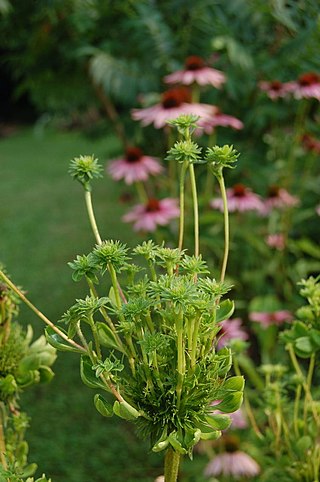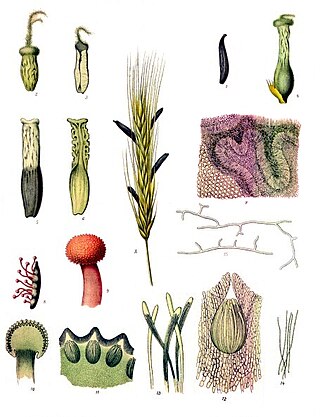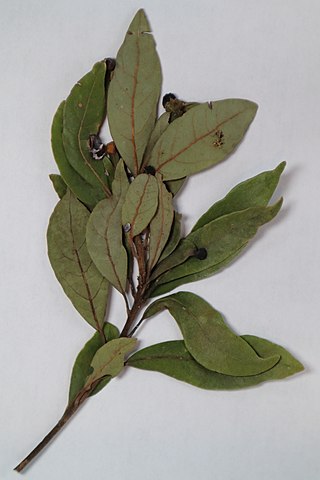
Bamboos are a diverse group of mostly evergreen perennial flowering plants making up the subfamily Bambusoideae of the grass family Poaceae. Giant bamboos are the largest members of the grass family, in the case of Dendrocalamus sinicus individual culms reaching a length of 46 meters, up to 36 centimeters in thickness and a weight of up to 450 kilograms. The internodes of bamboos can also be of great length. Kinabaluchloa wrayi has internodes up to 2.5 meters in length. and Arthrostylidium schomburgkii with lower internodes up to 5 meters in length, exceeded in length only by papyrus. By contrast, the culms of the tiny bamboo Raddiella vanessiae of the savannas of French Guiana are only 10–20 millimeters in length by about two millimeters in width. The origin of the word "bamboo" is uncertain, but it probably comes from the Dutch or Portuguese language, which originally borrowed it from Malay or Kannada.

Cytisus scoparius, the common broom or Scotch broom, is a deciduous leguminous shrub native to western and central Europe. In Britain and Ireland, the standard name is broom; this name is also used for other members of the Genisteae tribe, such as French broom or Spanish broom; and the term common broom is sometimes used for clarification. In other English-speaking countries, the most common name is "Scotch broom" ; however, it is known as English broom in Australia.

Phytoplasmas are obligate intracellular parasites of plant phloem tissue and of the insect vectors that are involved in their plant-to-plant transmission. Phytoplasmas were discovered in 1967 by Japanese scientists who termed them mycoplasma-like organisms. Since their discovery, phytoplasmas have resisted all attempts at in vitro culture in any cell-free medium; routine cultivation in an artificial medium thus remains a major challenge. Phytoplasmas are characterized by the lack of a cell wall, a pleiomorphic or filamentous shape, a diameter normally less than 1 μm, and a very small genome.

Spartium junceum, known as Spanish broom, rush broom, or weaver's broom, it is a species of flowering plant in the family Fabaceae and the sole species in the genus Spartium. It is closely related to the other brooms.

The Clavicipitaceae are a family of fungi within the order Hypocreales. A 2008 estimate placed 43 genera in the family, but a study in 2020 has increased this number to 50.
Chrysosporium is a genus of hyaline hyphomycetes fungi in the family Onygenaceae.

Moniliophthora roreri is a basidiomycete fungus that causes frosty pod rot disease, one of the most serious problems for cacao production in Latin America. This disease and together with witches’ broom disease and black pod rot constitute the cacao disease trilogy. It causes serious losses in southwestern parts of South America; spores are dry and powdery and are spread easily by water movement, wind, or movement of pods; disease spread is highest during periods of high rainfall.

Aecidium magellanicum, commonly known as the calafate rust, is a species of rust fungi. This fungus can cause a growth defect known as a witches broom, an excessive growth of stems from a single point on a branch. The species is known to infect the evergreen shrub Berberis buxifolia in Argentina and Chile.
Heteroepichloë is a genus of fungi within the Clavicipitaceae family.

Taphrina padi is a fungal plant pathogen that induces the form of pocket plum gall that occurs on bird cherry. The gall is a chemically induced distortion of the fruits, which are swollen, hollow, curved and greatly elongated, without a seed or stone, but retaining the style. The twigs on infected plants may also be deformed with small strap-shaped leaves.

Geosmithia is a genus of anamorphic fungi of uncertain familial placement in the order Hypocreales. The genus, circumscribed by Australian mycologist John Pitt in 1979, is widely distributed. A 2008 estimate placed ten species in the genus, but several new species have since been described. Thousand cankers disease, which affects economically important black walnut populations in North America, is caused by Geosmithia morbida.
Butyriboletus roseogriseus is a pored mushroom in the family Boletaceae found in Europe. It was originally described as a species of Boletus in 2014, but transferred later that year to the newly created genus Butyriboletus.

Raffaelea is a genus of ambrosia fungi in the family Ophiostomataceae. It was circumscribed by mycologists Josef Adolph von Arx and Grégoire L. Hennebert in 1965 with Raffaelea ambrosiae as the type species. The genus is named in honor of Italian botanist Raffaele Ciferri.

Longan witches broom-associated virus is a species of positive-sense single-stranded RNA virus that has not been assigned to a genus within the family Potyviridae. It is thought to be the cause of witch's broom in longan, a large tropical tree from southeastern Asia of economic value. Longan witches broom disease is a condition that was first described in 1941. The virus was found in symptomatic plants and absent in healthy plants, but not all of Koch's postulates have been fulfilled.
Eurotium is a genus of fungi belonging to the family Aspergillaceae.
Commelinaceomyces is a genus of fungi in the family Clavicipitaceae.

Taphrina betulina is a fungal plant pathogen that causes the gall, witches broom, which is a chemical infection of birch buds or the developing shoots, leading to a proliferation of growth. It was first described by Emil Rostrup in 1883 and is found in Europe, New Zealand and North America.

Dictyosporium is the type genus of fungi belonging to the family Dictyosporiaceae. By an estimate in 2018 it is formed by 45 species.
Lentithecium is a genus of fungi belonging to the family Lentitheciaceae.

Cystotheca lanestris, the live oak witch's broom fungus, is a species of mildew that infects buds and induces stem galls called witch's brooms on oak trees in California, Arizona, and Mexico in North America. Witch's brooms are "abnormal clusters of shoots that are thickened, elongated, and highly branched." This fungus infects coast live oaks, interior live oaks, canyon live oaks, valley oaks, and tanoaks, and is most commonly found along the coast. Research published in 2023 newly describes this fungus as also growing in association with Quercus laceyi and Q. toumeyi.













